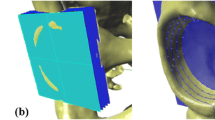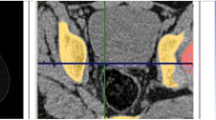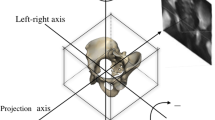Abstract
Objective
The purpose of this study was to determine if there is an anatomic relationship between pelvic geometry and acetabular depth.
Materials and methods
One hundred and fifty-one anteroposterior pelvic radiographs (157 hip joints) were selected and analyzed in a retrospective fashion. Six parameters, including iliac offset, ischial offset, acetabular offset, pelvic height, center-edge (CE) angle of Wiberg, and acetabular index (AI) angle of Tönnis were measured for each of the hip joints. Based on the defined variables, three formulas (formulas 1, 2, and 3) were calculated to represent the hemi-pelvis slope.
Results
There was a strong relationship between the hemi-pelvis slope and probability of acetabular dysplasia. Wider upper pelvis was associated with deeper acetabulum and wider lower pelvis was associated with dysplastic acetabulum.
Conclusions
Pelvic anatomic dimensions and the relationship between them are strongly correlated with hip dysplasia indices. Dysplastic hips tend to be found in pelvises with lower slope (low width of the upper pelvis at the level of iliac crest and high width of the lower part at the level of ischium).






Similar content being viewed by others
References
Yoshimura N, Campbell L, Hashimoto T, Kinoshita H, Okayasu T, Wilman C, et al. Acetabular dysplasia and hip osteoarthritis in Britain and Japan. Br J Rheumatol. 1998;37(11):1193–7.
Inoue K, Wicart P, Kawasaki T, Huang J, Ushiyama T, Hukuda S, et al. Prevalence of hip osteoarthritis and acetabular dysplasia in French and Japanese adults. Rheumatology (Oxford, England). 2000;39(7):745–8.
Lau EM, Lin F, Lam D, Silman A, Croft P. Hip osteoarthritis and dysplasia in Chinese men. Ann Rheum Dis. 1995;54(12):965–9.
Wiberg G. Studies on dysplastic acetabula and congenital subluxation of the hip. With special reference to the complication of osteoarthritis. Acta Chir Scand. 1939;83(58):5–135.
Cooperman DR, Wallensten R, Stulberg SD. Acetabular dysplasia in the adult. Clin Orthop Relat Res. 1983;175:79–85.
Harris WH. Etiology of osteoarthritis of the hip. Clin Orthop Relat Res. 1986;213:20–33.
Hasegawa Y, Iwata H, Mizuno M, Genda E, Sato S, Miura T. The natural course of osteoarthritis of the hip due to subluxation or acetabular dysplasia. Arch Orthop Trauma Surg. 1992;111(4):187–91.
Murphy SB, Ganz R, Muller ME. The prognosis in untreated dysplasia of the hip. A study of radiographic factors that predict the outcome. J Bone Joint Surg. 1995;77(7):985–9.
Jacobsen S, Sonne-Holm S, Soballe K, Gebuhr P, Lund B. Hip dysplasia and osteoarthrosis: a survey of 4151 subjects from the osteoarthrosis substudy of the Copenhagen City Heart Study. Acta Orthop. 2005;76(2):149–58.
Troelsen A. Assessment of adult hip dysplasia and the outcome of surgical treatment. Dan Med J. 2012;59(6):B4450.
Siebenrock KA, Kalbermatten DF, Ganz R. Effect of pelvic tilt on acetabular retroversion: a study of pelves from cadavers. Clin Orthop Relat Res. 2003;407:241–8.
Jacobsen S. Adult hip dysplasia and osteoarthritis. Studies in radiology and clinical epidemiology. Acta Orthop Suppl. 2006;77(324):1–37.
Troelsen A, Romer L, Kring S, Elmengaard B, Soballe K. Assessment of hip dysplasia and osteoarthritis: variability of different methods. Acta Radiol (Stockholm, Sweden : 1987). 2010;51(2):187–93.
Stubbs AJ, Anz AW, Frino J, Lang JE, Weaver AA, Stitzel JD. Classic measures of hip dysplasia do not correlate with three-dimensional computer tomographic measures and indices. Hip Int: J Clin Exp Res Hip Pathol Ther. 2011;21(5):549–58.
Paul L, Docquier P-L, Cartiaux O, Banse X. Measurement of radiographic magnification in the pelvis using archived CT scans. Acta Orthop Belg. 2008;74(5):623.
Gosvig KK, Jacobsen S, Sonne-Holm S, Palm H, Troelsen A. Prevalence of malformations of the hip joint and their relationship to sex, groin pain, and risk of OsteoarthritisA population-based survey. J Bone Joint Surg. 2010;92(5):1162–9.
Guenther WC. Some probabilities available from desk calculators and their relation to tables. Am Stat. 1977;31(1):41–5.
Monazzam S, Bomar J, Cidambi K, Kruk P, Hosalkar H. Lateral center-edge angle on conventional radiography and computed tomography. Clin Orthop Relat Res. 2013;471(7):2233–7.
Walter SD, Eliasziw M, Donner A. Sample size and optimal designs for reliability studies. Stat Med. 1998;17(1):101–10.
Wedge JH, Wasylenko M. The natural history of congenital dislocation of the hip: a critical review. Clin Orthop Relat Res. 1978;137:154–62.
Weinstein SL. Natural history of congenital hip dislocation (CDH) and hip dysplasia. Clin Orthop Relat Res. 1987;225:62–76.
Reijman M, Hazes JM, Pols HA, Koes BW, Bierma-Zeinstra SM. Acetabular dysplasia predicts incident osteoarthritis of the hip: the Rotterdam study. Arthritis Rheum. 2005;52(3):787–93.
Jacobsen S, Sonne-Holm S. Hip dysplasia: a significant risk factor for the development of hip osteoarthritis. A cross-sectional survey. Rheumatology (Oxford, England). 2005;44(2):211–8.
Matheney T, Kim Y-J, Zurakowski D, Matero C, Millis M. Intermediate to long-term results following the Bernese periacetabular osteotomy and predictors of clinical outcome. J Bone Jt Surg. 2009;91(9):2113–23.
Nunley RM, Prather H, Hunt D, Schoenecker PL, Clohisy JC. Clinical presentation of symptomatic acetabular dysplasia in skeletally mature patients. J Bone Joint Surg Am. 2011;93(Suppl 2):17–21.
Author information
Authors and Affiliations
Corresponding author
Ethics declarations
Conflict of interest
The authors declare that they have no conflicts of interest.
Rights and permissions
About this article
Cite this article
Sadeghi-Naini, M., Taghipour, S., Savadkouhi, A.G. et al. Hemi-pelvic slope is correlated with the acetabular depth in adults—a radiological study. Skeletal Radiol 47, 1119–1125 (2018). https://doi.org/10.1007/s00256-018-2892-x
Received:
Revised:
Accepted:
Published:
Issue Date:
DOI: https://doi.org/10.1007/s00256-018-2892-x




